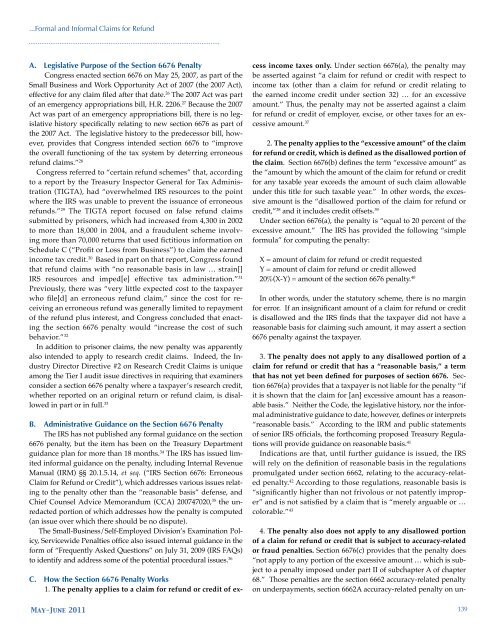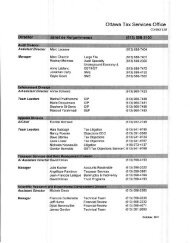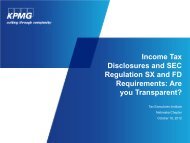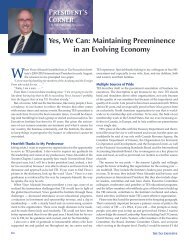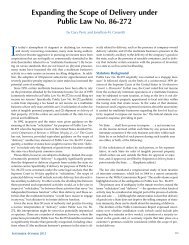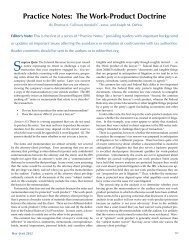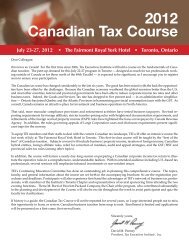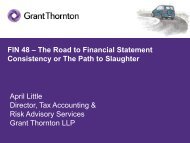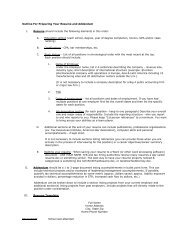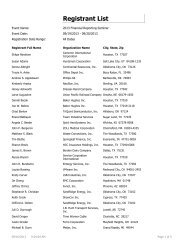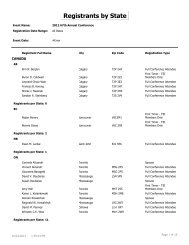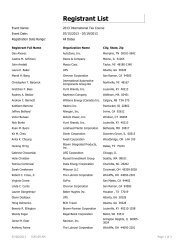recent Developments to Consider when Filing Formal and Informal ...
recent Developments to Consider when Filing Formal and Informal ...
recent Developments to Consider when Filing Formal and Informal ...
You also want an ePaper? Increase the reach of your titles
YUMPU automatically turns print PDFs into web optimized ePapers that Google loves.
...<strong>Formal</strong> <strong>and</strong> <strong>Informal</strong> Claims for RefundA. Legislative Purpose of the Section 6676 PenaltyCongress enacted section 6676 on May 25, 2007, as part of theSmall Business <strong>and</strong> Work Opportunity Act of 2007 (the 2007 Act),effective for any claim filed after that date. 26 The 2007 Act was par<strong>to</strong>f an emergency appropriations bill, H.R. 2206. 27 Because the 2007Act was part of an emergency appropriations bill, there is no legislativehis<strong>to</strong>ry specifically relating <strong>to</strong> new section 6676 as part ofthe 2007 Act. The legislative his<strong>to</strong>ry <strong>to</strong> the predecessor bill, however,provides that Congress intended section 6676 <strong>to</strong> “improvethe overall functioning of the tax system by deterring erroneousrefund claims.” 28Congress referred <strong>to</strong> “certain refund schemes” that, according<strong>to</strong> a report by the Treasury Inspec<strong>to</strong>r General for Tax Administration(TIGTA), had “overwhelmed IRS resources <strong>to</strong> the pointwhere the IRS was unable <strong>to</strong> prevent the issuance of erroneousrefunds.” 29 The TIGTA report focused on false refund claimssubmitted by prisoners, which had increased from 4,300 in 2002<strong>to</strong> more than 18,000 in 2004, <strong>and</strong> a fraudulent scheme involvingmore than 70,000 returns that used fictitious information onSchedule C (“Profit or Loss from Business”) <strong>to</strong> claim the earnedincome tax credit. 30 Based in part on that report, Congress foundthat refund claims with “no reasonable basis in law … strain[]IRS resources <strong>and</strong> imped[e] effective tax administration.” 31Previously, there was “very little expected cost <strong>to</strong> the taxpayerwho file[d] an erroneous refund claim,” since the cost for receivingan erroneous refund was generally limited <strong>to</strong> repaymen<strong>to</strong>f the refund plus interest, <strong>and</strong> Congress concluded that enactingthe section 6676 penalty would “increase the cost of suchbehavior.” 32In addition <strong>to</strong> prisoner claims, the new penalty was apparentlyalso intended <strong>to</strong> apply <strong>to</strong> research credit claims. Indeed, the IndustryDirec<strong>to</strong>r Directive #2 on Research Credit Claims is uniqueamong the Tier I audit issue directives in requiring that examinersconsider a section 6676 penalty where a taxpayer’s research credit,whether reported on an original return or refund claim, is disallowedin part or in full. 33B. Administrative Guidance on the Section 6676 PenaltyThe IRS has not published any formal guidance on the section6676 penalty, but the item has been on the Treasury Departmentguidance plan for more than 18 months. 34 The IRS has issued limitedinformal guidance on the penalty, including Internal RevenueManual (IRM) §§ 20.1.5.14, et seq. (“IRS Section 6676: ErroneousClaim for Refund or Credit”), which addresses various issues relating<strong>to</strong> the penalty other than the “reasonable basis” defense, <strong>and</strong>Chief Counsel Advice Memor<strong>and</strong>um (CCA) 200747020, 35 the unredactedportion of which addresses how the penalty is computed(an issue over which there should be no dispute).The Small-Business/Self-Employed Division’s Examination Policy,Servicewide Penalties office also issued internal guidance in theform of “Frequently Asked Questions” on July 31, 2009 (IRS FAQs)<strong>to</strong> identify <strong>and</strong> address some of the potential procedural issues. 36C. How the Section 6676 Penalty Works1. The penalty applies <strong>to</strong> a claim for refund or credit of excessincome taxes only. Under section 6676(a), the penalty maybe asserted against “a claim for refund or credit with respect <strong>to</strong>income tax (other than a claim for refund or credit relating <strong>to</strong>the earned income credit under section 32) … for an excessiveamount.” Thus, the penalty may not be asserted against a claimfor refund or credit of employer, excise, or other taxes for an excessiveamount. 372. The penalty applies <strong>to</strong> the “excessive amount” of the claimfor refund or credit, which is defined as the disallowed portion ofthe claim. Section 6676(b) defines the term “excessive amount” asthe “amount by which the amount of the claim for refund or creditfor any taxable year exceeds the amount of such claim allowableunder this title for such taxable year.” In other words, the excessiveamount is the “disallowed portion of the claim for refund orcredit,” 38 <strong>and</strong> it includes credit offsets. 39Under section 6676(a), the penalty is “equal <strong>to</strong> 20 percent of theexcessive amount.” The IRS has provided the following “simpleformula” for computing the penalty:X = amount of claim for refund or credit requestedY = amount of claim for refund or credit allowed20%(X-Y) = amount of the section 6676 penalty. 40In other words, under the statu<strong>to</strong>ry scheme, there is no marginfor error. If an insignificant amount of a claim for refund or creditis disallowed <strong>and</strong> the IRS finds that the taxpayer did not have areasonable basis for claiming such amount, it may assert a section6676 penalty against the taxpayer.3. The penalty does not apply <strong>to</strong> any disallowed portion of aclaim for refund or credit that has a “reasonable basis,” a termthat has not yet been defined for purposes of section 6676. Section6676(a) provides that a taxpayer is not liable for the penalty “ifit is shown that the claim for [an] excessive amount has a reasonablebasis.” Neither the Code, the legislative his<strong>to</strong>ry, nor the informaladministrative guidance <strong>to</strong> date, however, defines or interprets“reasonable basis.” According <strong>to</strong> the IRM <strong>and</strong> public statementsof senior IRS officials, the forthcoming proposed Treasury Regulationswill provide guidance on reasonable basis. 41Indications are that, until further guidance is issued, the IRSwill rely on the definition of reasonable basis in the regulationspromulgated under section 6662, relating <strong>to</strong> the accuracy-relatedpenalty. 42 According <strong>to</strong> those regulations, reasonable basis is“significantly higher than not frivolous or not patently improper”<strong>and</strong> is not satisfied by a claim that is “merely arguable or …colorable.” 434. The penalty also does not apply <strong>to</strong> any disallowed portionof a claim for refund or credit that is subject <strong>to</strong> accuracy-relatedor fraud penalties. Section 6676(c) provides that the penalty does“not apply <strong>to</strong> any portion of the excessive amount … which is subject<strong>to</strong> a penalty imposed under part II of subchapter A of chapter68.” Those penalties are the section 6662 accuracy-related penaltyon underpayments, section 6662A accuracy-related penalty on un-May-June 2011 139


